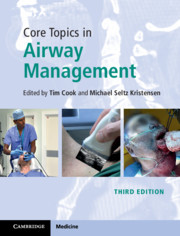Book contents
- Core Topics in Airway Management
- Core Topics in Airway Management
- Copyright page
- Contents
- Contributors
- Foreword
- Preface to the Third Edition
- Section 1 Airway Management: Background and Techniques
- Section 2 Airway Management: Clinical Settings and Subspecialties
- Chapter 22 The Airway in Obstetrics
- Chapter 23 The Paediatric Airway
- Chapter 24 Airway Management in Obesity
- Chapter 25 Maxillofacial and Dental Surgery
- Chapter 26 Ear, Nose and Throat Surgery: Airway Management
- Chapter 27 Lung Separation
- Chapter 28 Airway Management in the Critically Ill
- Chapter 29 The Patient with a Tracheostomy
- Chapter 30 Pre-hospital and Trauma Airway Management
- Chapter 31 Airway Management during CPR
- Chapter 32 The Bloody and Bleeding Airway
- Chapter 33 The Airway in Anaesthesia for Transoral Robotic Surgery
- Section 3 Airway Management: Organisation
- Index
- References
Chapter 22 - The Airway in Obstetrics
from Section 2 - Airway Management: Clinical Settings and Subspecialties
Published online by Cambridge University Press: 03 October 2020
- Core Topics in Airway Management
- Core Topics in Airway Management
- Copyright page
- Contents
- Contributors
- Foreword
- Preface to the Third Edition
- Section 1 Airway Management: Background and Techniques
- Section 2 Airway Management: Clinical Settings and Subspecialties
- Chapter 22 The Airway in Obstetrics
- Chapter 23 The Paediatric Airway
- Chapter 24 Airway Management in Obesity
- Chapter 25 Maxillofacial and Dental Surgery
- Chapter 26 Ear, Nose and Throat Surgery: Airway Management
- Chapter 27 Lung Separation
- Chapter 28 Airway Management in the Critically Ill
- Chapter 29 The Patient with a Tracheostomy
- Chapter 30 Pre-hospital and Trauma Airway Management
- Chapter 31 Airway Management during CPR
- Chapter 32 The Bloody and Bleeding Airway
- Chapter 33 The Airway in Anaesthesia for Transoral Robotic Surgery
- Section 3 Airway Management: Organisation
- Index
- References
Summary
Airway management and failed intubation in the pregnant woman present unique challenges which differ from the non-pregnant patient. The provision of general anaesthesia in the obstetric population requires additional considerations of the physiological changes in pregnancy, environmental factors and the safe outcome of mother and baby. Appropriate team planning, preparation and performance of rapid sequence induction should be carried out in order to help to reduce adverse airway events. The OAA/DAS guidelines are designed to help to standardise teaching, reduce the incidence of failed intubation and give guidance on further management should failed intubation occur.
- Type
- Chapter
- Information
- Core Topics in Airway Management , pp. 185 - 191Publisher: Cambridge University PressPrint publication year: 2020

